An invitation to a formal dinner is an event not to be missed. We discuss what to expect and how to prepare for this ancient and highly ritualized event.
Variety in Formal Dining
In formal dining, as with informal dining, knowing the context of your dinner is very important. Will the dinner occur in Boston? London? Paris? Berlin? Shanghai?
While there are certainly differences between countries, there are also differences within countries. If you are unsure what to expect, ask. If you work for an international organization, they may have on staff or retainer a protocol officer. This person can assist you with your etiquette concerns. Also ask co-workers or acquaintances. Of course, you may be nervous.
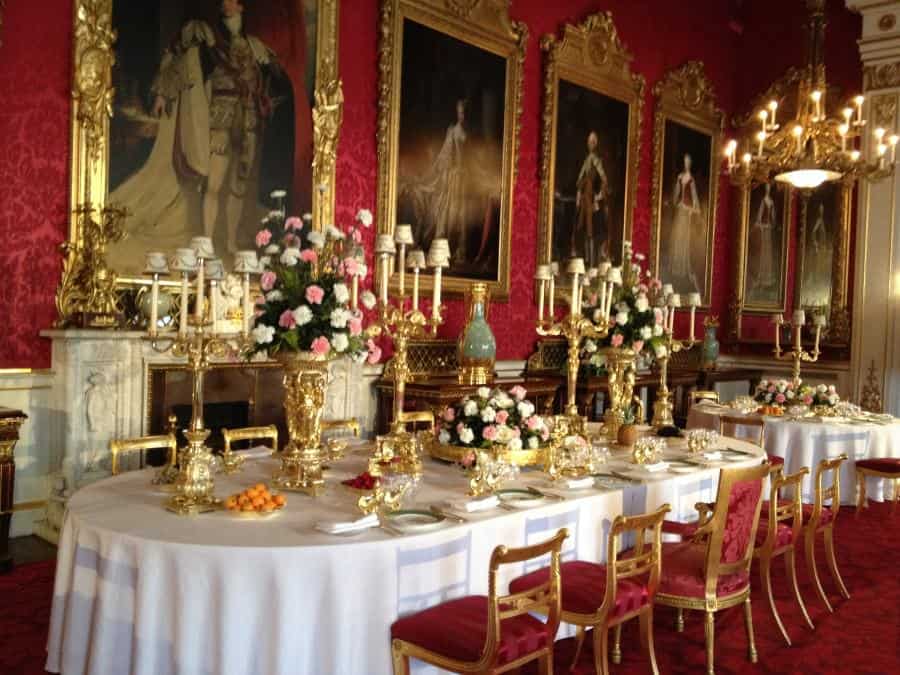
Formal Dining is on a Continuum
Dining exists on a continuum from the most basic informal meal to the most lavish royal dinner. Within formal dining, a five-course meal served in a 3-star Michelin restaurant is very different from a small dinner at Buckingham Palace. While dining at a Michelin restaurant is far more formal compared to many dining experiences, it is still the least formal of a formal dining experience.
A formal dining event is distinguished from an informal one in several ways.
- A formal dinner requires a man to wear a evening attire such as a tuxedo or sometimes even white tie.
- All food is served from the kitchen. Guests do not handle serving platters nor do they pass dishes.
- Neither serving dishes nor utensils are placed on the table. All service and table clearing is performed by butlers and other service staff.
- A formal dinner is also distinguished by multiple courses as well as by the serving of demitasse, brandy and liqueurs.
- And finally, what distinguishes a formal dinner from all other dinners is the order of service and the seating protocols. While a dinner at Michelin is much more formal than a local coffee shop, it is, in comparison to formal state, military, royal and private banquets, informal, if for no other reason that there are no required seating arrangements.
We will focus on the most formal dining event, understanding that the skills and style to successfully participate in a formal banquet given at the German Embassy will provide all the necessary skills to dine at Epicure in Paris.
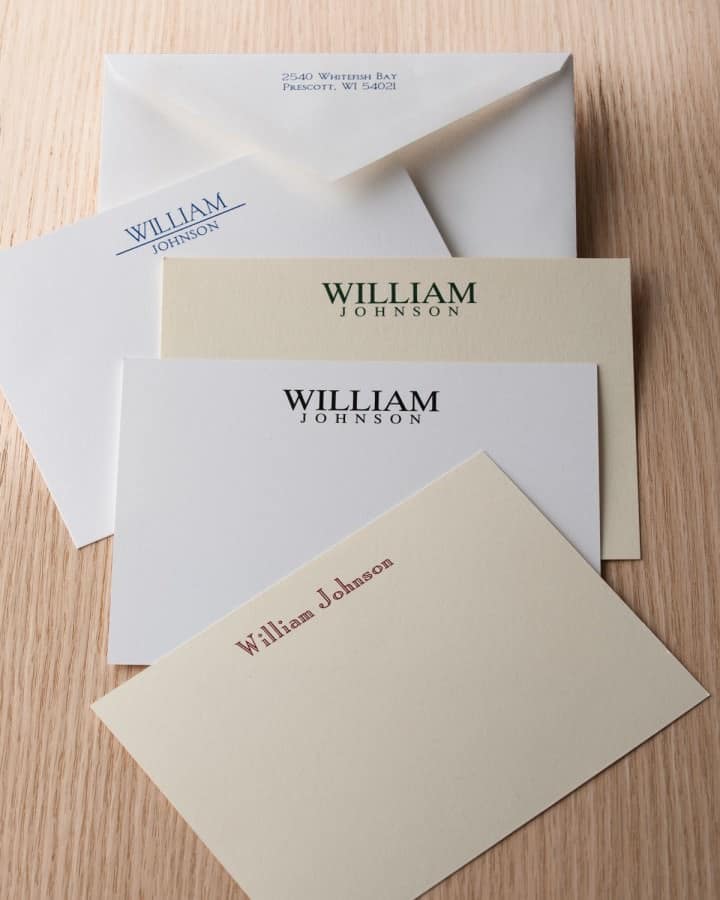
Before the event
RSVP
Your response to an invitation to a formal dinner should be hand written, ideally on a headed correspondence card, but that is not required – and in the third person: “Mr. X thanks (inviter(s)) for their kind invitation on (day of week), (day and month) and has much pleasure in accepting.”
If a telephone number or email address is provided as a way to accept (or decline) the invitation, then by all means utilize those methods.
Formal events may have hundreds of invitees, particularly at embassies, though the Royal Family of Great Britain may host a dinner with a few thousand guests. The person collecting responses is a member of the support staff and wishes to know whether or not you will attend. How you tell them may be less important, though, again, please consult with a local expert.
Formal Evening Attire
The Gentleman’s Gazette review of the tuxedos worn at evening reception of the Royal Wedding offers great suggestions on how to dress classically and appropriately. Your event may even require the wearing of white tie. Ask, if you are not sure about the appropriate dress.
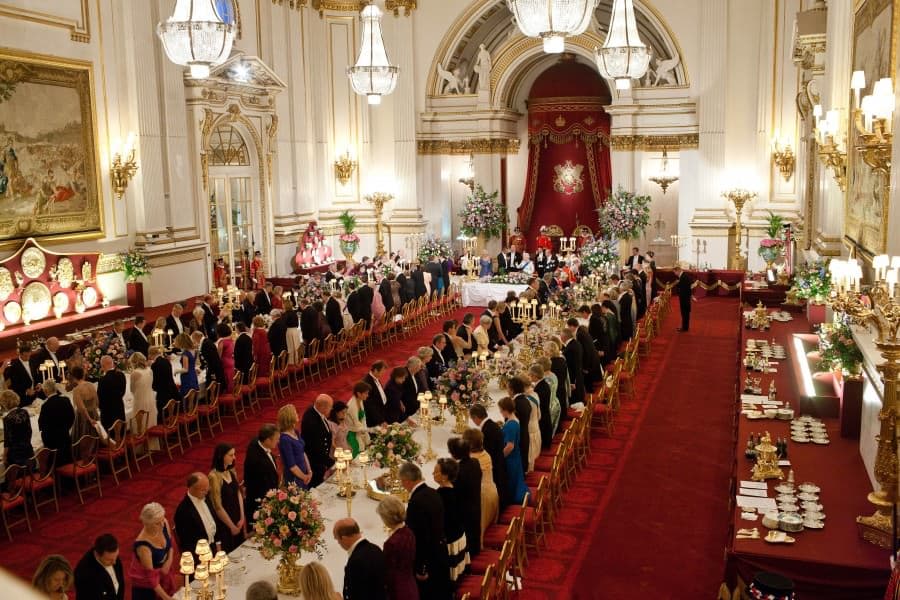
Find the Perfect First Date Restaurant
What to expect at a Formal Dinner
Formal dinners have historically been opportunities for royalty to honor important individuals as well as showcase the wealth and opulence of the host and hostess. The rules, referred to as protocols, are derived from traditions emerging from Europe hundreds of years ago. Aside from the profusion of porcelain, crystal, silver and linens, formal dinners follow rules about how people are seated, usually alternating between men and women with the host at one end and the hostess at the opposite end; in what order they are seated, the host and hostess escort or are escorted by the lady and man of honor to the table; and how the meal is plated and served.
In the following video, you can see President Obama at a State Banquet with the Queen not following protocol. During his speech, he made a long pause, and so the British National Anthem was played. Disregarding protocol, Obama continued to deliver his salutations and raised his glass, while everybody around him stood still listening to the anthem. One the one hand, the anthem was played too early, on the other hand he should have stopped talking.
While growing gender parity and the emergence of gay marriages has changed the protocols somewhat in the United States, the general rule that neither married nor engaged couples will be seated adjacent to one another still stands. And don’t be surprised if the men at the banquet table rise when the hostess rises. You may also find yourself seated at round tables, or, at very large events, far from the host and hostess.
You may receive a menu upon arrival or find one next to your place setting. You may know where to sit by name card at large gatherings or by direction from the hostess in a more intimate setting. The larger the event the stricter the protocol. For example, at a very large event of 1,000 guests, you will probably find the menu card at your place setting and will be seated by name card. You only interact with the host and hostess once during the entire evening.
The event begins with cocktails, which last an hour or more. At smaller events, you will be greeted by the hostess. At larger events, such as state dinners, you will be greeted by a member of the staff. Other staff will assist you with your coat and wraps.
The preparation for a formal dinner is immense. According to Butlers Guild, it may take a professional butler “about 15 minutes per place setting to create a dinner table that lives up to his standards. So setting a table for 12 persons keeps him busy for hours.” Table runners, plates and cutlery are placed according to exact specifications: the edge of the table runner should be ½ inch from the table’s edge; plates one inch from the edge of the table; the handles of cutlery also one inch. Flower arrangements are at eye level and candelabras are so that everyone can make eye contact.
In this youtube video, Nigel McEvoy, Palace Steward at Buckingham Palace describes the meticulous preparations of a small dinner (3o people) given by the Queen for prominent American residents in the United Kingdom.
The number of courses for the meal varies. The traditional French meal is thirteen courses, but the usual number today is between four and six courses. The last dinner on the Titanic for first class guests contained ten courses. The menu may be planned entirely by the chef, the chef and the head butler, the head butler and the host or the head butler alone.
Neither the host, the hostess nor the guests assist with the serving of the meal. All food preparation, service and removal is completed by staff, some permanent while most are temporary. Food service proceeds to the right, counterclockwise, starting with the guest of honor. Beverage service progresses to the left, clockwise. At a formal dinner, individual portions are prearranged and presented on a platter. The greater the courses, the smaller the portions and the less wine poured per course. Formal dining includes multiple courses and second helpings are not offered. Once serve ware is taken from the dining room, it is not returned.
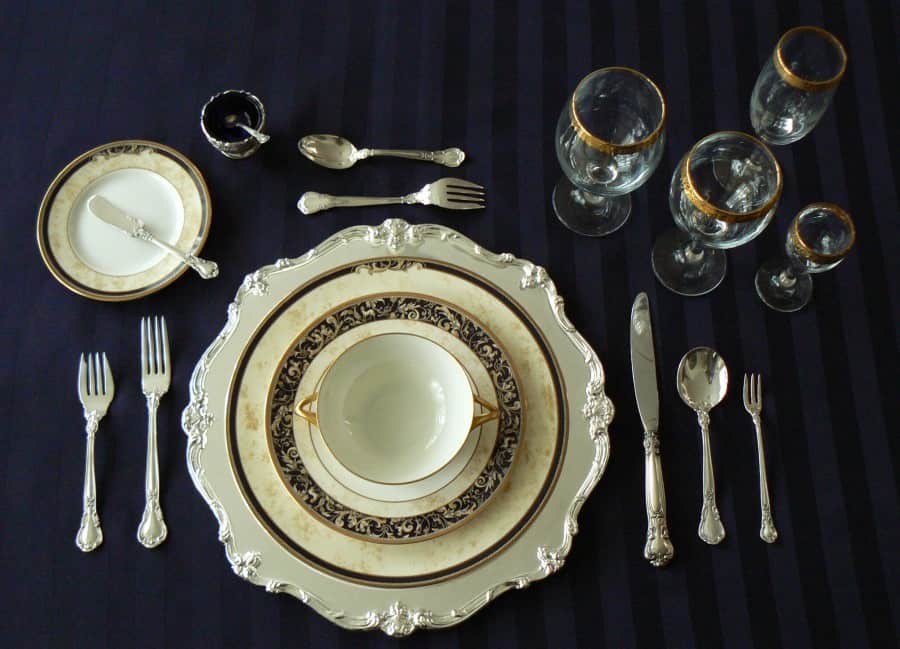
Food is served on a hot or cold plate. A plate’s temperature will be appropriate for the food they contain. This practice is not unique to formal dinners. Michelin-rated restaurants, among others, ensure the proper plate temperature so as to enhance the flavor of each course. Plates are served and cleared from the left side and one at a time. When a used plate is removed, the butler simultaneously slides a fresh plate in its place. As both hands are involved in this process, plate removal at formal dinners is done one plate at a time.
Beverages are served and cleared from the right side. The goblet and wine glasses remain on the table throughout the entire meal. Only the sherry glass is removed at the end of the course it accompanies. With your permission, the butler will remove the wine glass if you inform him that you are allergic or prefer not to drink. If the same wine is offered over consecutive courses, it is served in the same glass.
Order of Service
Seating arrangements vary somewhat based on whether or not strict protocol is being followed. If strict protocol is being followed, then men escort women to their seats. Formal dinners still follow more formal gendered behavior, with an equal number of men and women in attendance and men standing until the hostess is seated. If the occasion is more relaxed, women may seat themselves before the hostess.
Many formal dinners fete honored guests. If there is an honored guest, that guest is served first. The man of honor sits to the right of the hostess and the lady of honor sits to the right of the host. While the host escorts the lady of honor to her chair and pulls out the chair on his right and seats her, the hostess is escorted to her chair by the man of honor, but the gentleman on her left pulls out her chair and seats her. Once the honored guest is served, service begins with the lady of honor and moves counter-clockwise.
When no honored guest is present, service may begin with the most important female guest. A variety of methods have evolved to serve guests in a variety of formal circumstances. In every circumstance, the order of service commences with the lady of honor. How the remaining guests are served is often determined by the size of the banquet and how strictly protocol is being followed.
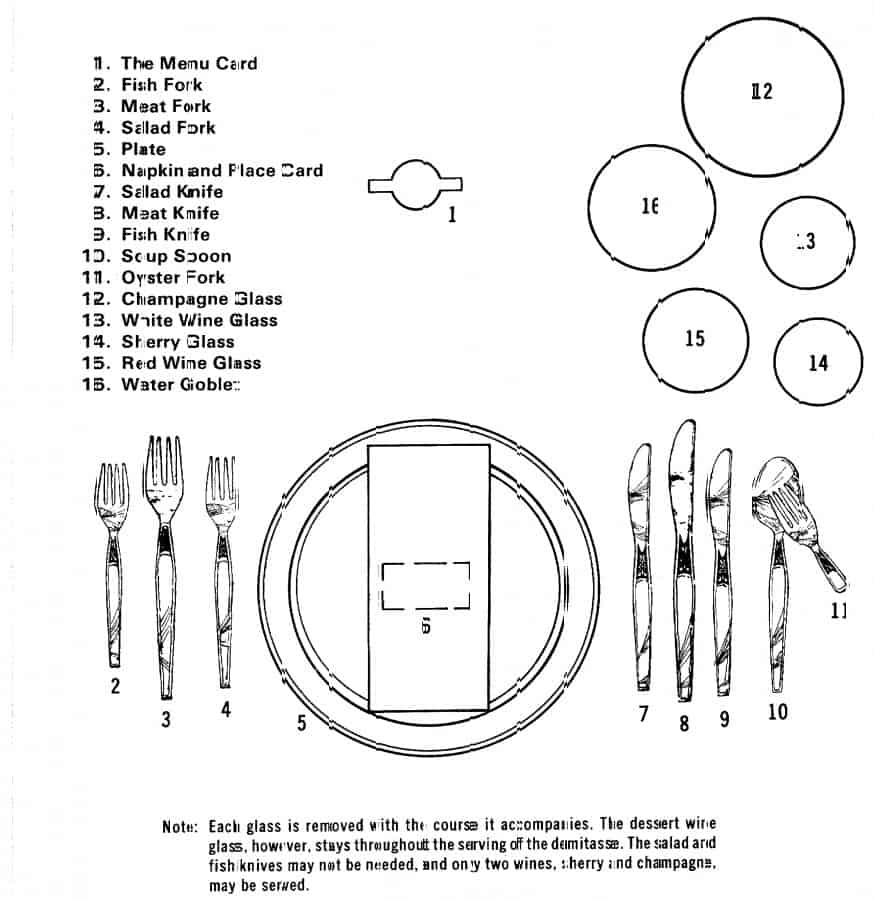
Place Settings at Formal Dinners
Because the the number and type of courses varies, so too will the place setting. In the most formal of settings, the dessert fork and spoon are brought to the table for the dessert course. For less formal settings, the fork and spoon are placed on the table above the plate, fork pointing right, spoon pointing left. When more courses are going to be served, the table is laid only for soup, fish and meat.
The Menu
Courses vary by occasion and may be as few as four courses or as high as 21. The first class meal on the Titanic is believed to have been ten courses. Much care goes into the preparation and execution of the menu. The goal is to create an experience where flavors complement one another and no taste is too overpowering. Temperatures and colors are contrasted throughout the meal.
A formal dinner is designed to last for hours and the course timing accounts for this fact. Compote dishes remain on the table throughout the dinner and guests may freely help themselves, usually between courses. A sorbet “intermezzo” may be served at the midway point of larger meals.
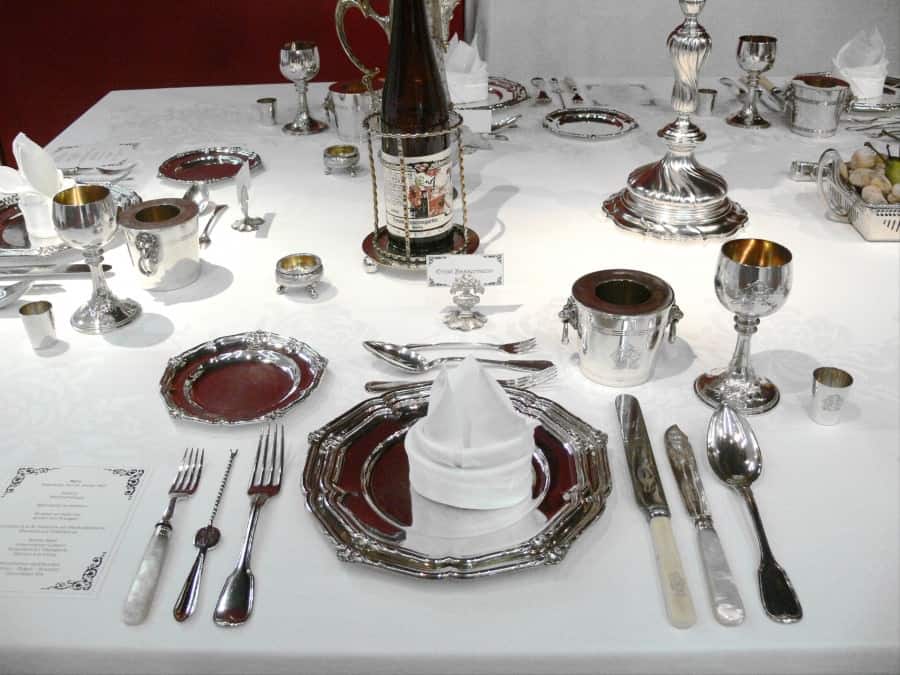
The course menu listed below is merely instructional. Some menus may have soup as the first course while others may serve shellfish first. Still other menus may serve oysters as an appetizer and lobster as a later course. An interesting aside is the American English idiomatic expression “from soup to nuts,” which conveys the meaning of beginning to end. Its use derives from the full course meal, which may progress from soup to a dessert of nuts.
For a nine-course meal (which reflects the expression “from soup to nuts”):
(Rolls are served dry in a low container lined with a linen doily or a napkin. Guests remove the roll from the container and lay it on the tablecloth.)
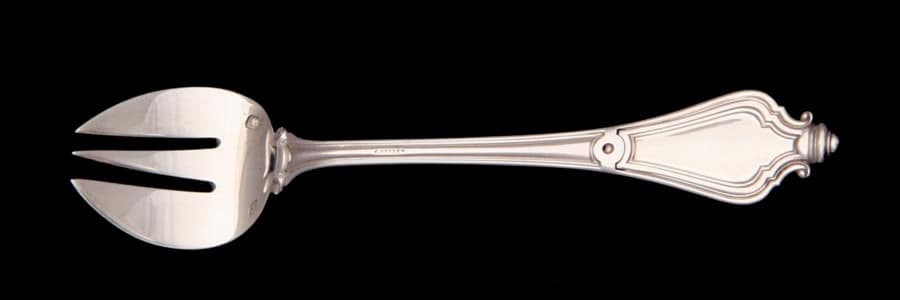
First course
Appetizer: Shellfish, with oysters being quite popular
How to eat shellfish, oysters and fish
Nancy Mitchell of the Etiquette Advocate describes how to eat difficult foods, including shellfish, oysters, and for most Americans, fish.
Second course
Soup: The soup plate is filled in the kitchen and laid on the service plate or served from a cart that is rolled around the room.
How to eat various kinds of soup in the US.
Third course
Fish: Fish may be brought on a platter and each guest serves herself from the platter. At formal events a bone dish will be provided. It will be placed between the bread plate and the charger plate and removed once the fish course is completed.
Fourth course
Game: Wild game indigenous to the region in which the event takes place may be served. Squab, elk, rabbit, quail, buffalo, venison and wild boar are popular choices.
Fifth course
Roast. A meat platter is filled with the main course and other vegetables, namely a roast, starch, vegetables, and garnish. Vegetables may also be offered separately, one or two bowls at a time. The butler will present sauces and condiments after the completion of the platter service.
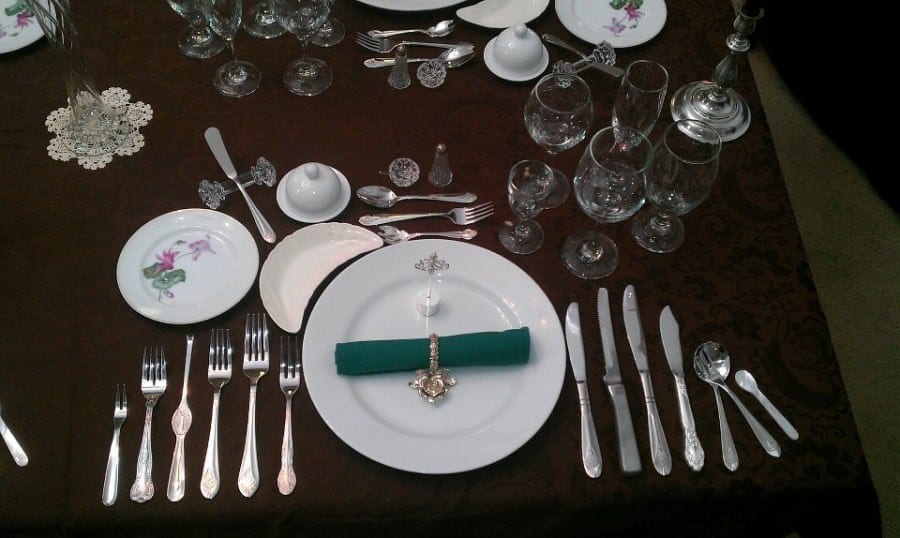
Sixth course
Salad or fruit and an optional cheese platter: A prearranged salad is served and may be followed by a cheese platter. Cheese is a digestif. An assortment of cheeses may be offered after the salad. Three different consistencies of cheese are usually served: hard like Cheddar, Parmigiano or Pecorino; semi-soft like blue-veined cheeses or mozzarella; and and soft cheese, like brie, Camembert or Neufchâtel.
Seventh Course
Dessert: Firm dessert, such as torte, is pre-sliced and served on a platter. Soft dessert, like parfait, is preserved in tall, narrow glasses and brought to the table on a tray. The dessert utensils are laid on the dessert plate. In a more informal formal event (at a private home) the dessert utensils may already be on the table.
Eighth Course
Fruit (and Cheese): The fruit plate is laid before the guest, along with a fruit fork and a fruit knife. Guests help themselves to fruit from the fruit bowl. But if the fruit bowl is inaccessible, the butler presents it to the guest. The hostess may also request sliced seasonal fruit passed on a platter. See above for how cheese may be served.
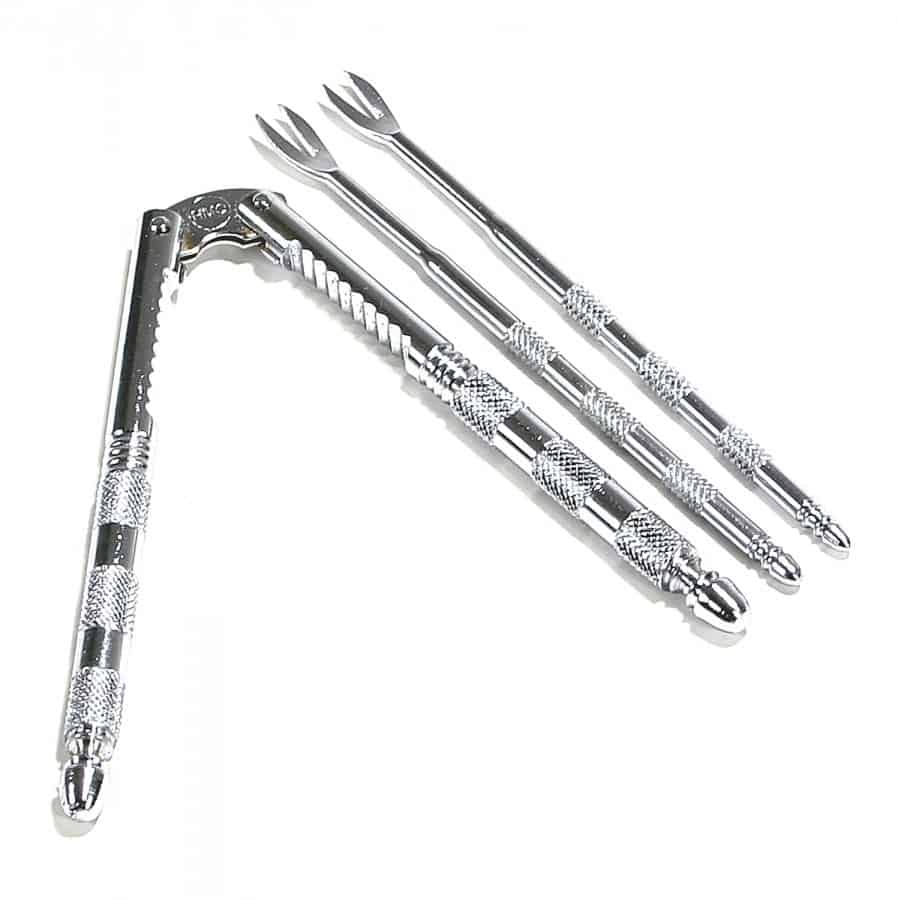
Ninth Course
Nuts and Candy: After the fruit course, compotes of candy and nuts are passed.
After Dinner Liqueurs and Brandy and Demitasse
Liqueurs, brandy and demitasse are all digestifs, taken after the meal, in a room separate from the dining area. Guests may join one another or women and men may take their drinks in separate rooms.
Liqueurs are often bitter as they will brighten the palate after a lengthy, and sometimes, heavy meal.
Demitasse is also a stimulant and traditionally taken black. If guests take their after dinner drinks together, a butler offers a coffee tray to each guest and asks if they would like a cup. If the guest answers yes, the butler places the cup and saucer on a table nearest the guest and pours it. If the guests separate after the meal, a maid may pour the coffee for female guests that desire it. For the men, demitasse is poured by a butler to each man who wants to partake.
Liquer and brandy may be offered during the coffee service or after.
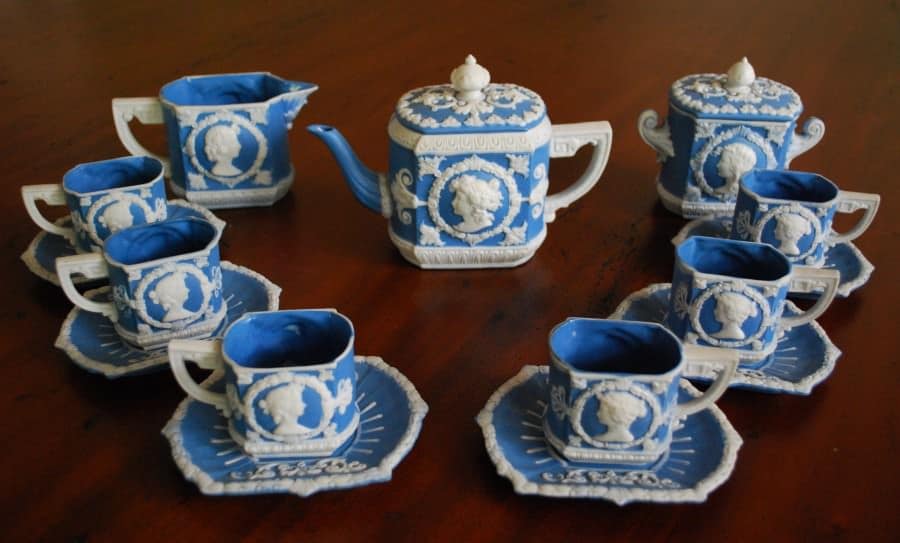
Cigarettes and Cigars
Cigarettes only appear at a hostess’s request and usually appear after demitasse. While fewer people smoke today, when cigarettes or cigars are offered, they are presented in a box on a silver tray. Traditionally the butler lights the guest’s cigarette. If after dinner drinks are taken separately by men and women, cigars may be offered to the men.
After Dinner
Traditionally entertainment followed formal dinners and included activities such as dancing or card playing. If such activities occur at your formal dinner, a late-night snack will be offered to revive you. A service of water and tumblers will also be provided throughout the remainder of the evening.
Saying Goodnight
Again, depending on the size of the banquet, the host and hostess may say good night to you; otherwise, they may make a public exit, with the expectation that you and other guests continue to enjoy yourselves. If the host and hostess can bid you good evening, the location for such goodbyes varies. A butler will assist you with your wraps and coats, escort you to the door and say good night. A valet will bring your car.
As you drive home, relish this experience.
Want to know more? Check out our Etiquette Guide!
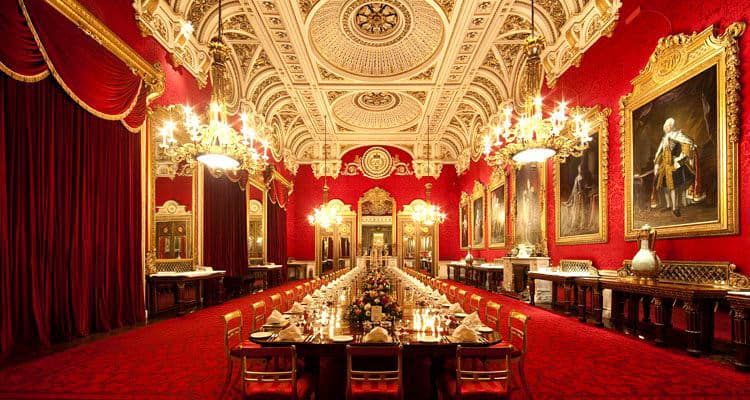
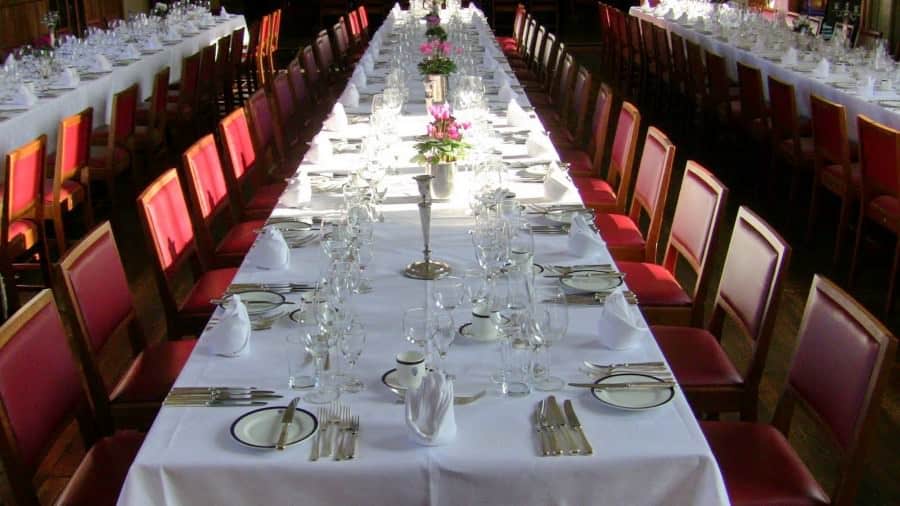
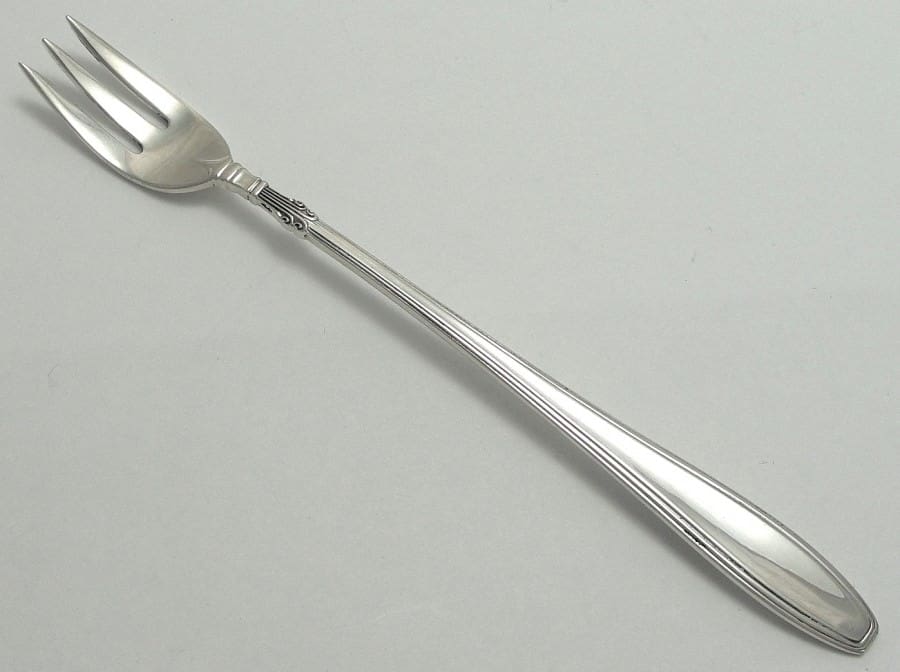


Another fascinating, informative article from Gentleman’s Gazette that I will read more than once. I would love the opportunity to attend a formal dinner. As an American, it irks me when our leaders blunder at formal events. I suspect though, that presidents Kennedy, Roosevelt and Eisenhower didn’t commit these types of mistakes.
I guess these gaffes make Americans look as cowboys or peasants, which is not true of course.
Thank you for your kind words. As an American, I agree with you. Though I do my best to remember other world leaders commit similar blunders.
Interesting, and no doubt a useful guide to anyone not used to formal dining. However, it should be pointed out that there will only be ONE butler and all other serving staff will be footmen (or footwomen in these gender-equality days) – a crucial thing to remember. The Royal Household has additional servants at different levels which can lead to much confusion for the uninitiated
But why single out Mr Obama as an example of gaffed protocol or ettiquete? His immediate predecessor was so toe-curlingly inept it is difficult to believe it was all by accident, and the Reagans no better. Eisenhower had the advantage of being schooled through his war-time role and mixing with others well accustomed to the ‘done’ thing.
When the American president blunders in this way, is not just him personally that is seen ridiculous but the nation he represents. The president’s advisers should prepare him and protect him from such gaffes, as there is no excuse for such bad behaviour at that level of society.
Perhaps the White House should be included in the Gentleman’s Gazette mailing list!
I agree the advisors. He should have been better advised, and the band should not have played right away. I think we all know the picture of Bush in his terrible white tie outfit. With Bush there were indeed many gaffes, but I could find a video of Obama’s faux pas. In regard to Reagan, I was too young to follow his gaffes personally, but maybe you can elaborate further.
Were there any memorable dinner faux pas?
The conventional cue for the national anthem to start are the words ‘The Queen.’ These should have been Obama’s final words, and his other remarks said as a preamble. He must have seen the other guests standing and not raising their glasses, and heard the anthem, but having started to speak what could he do? It is understandable that the president’s aides in Washington would not know the form, but a function of an embassy is to keep the head of state it represents properly informed on all matters. Both Obama and those within view of the camera are aware of his faux pas, but luckily the courteous least-said-soonest-mended remedy quickly came into play.
I understand the American embassy in London is traditionally the senior overseas office (Paris second) with now more than 200 years’ experience of events of this kind, and should be well informed on these matters. When successive presidents make such gaffes it perhaps says more about the politician than the embassy.
In the wake of the terrorist attacks on American embassies and elsewhere, the bewildered question of ‘Why do they hate us so much?’ was often asked. When the holder of the most senior job in America and the ‘first lady’ are seen to deliberately ignore and refuse to comply with other national courtesies and protocol, it is interpreted as scorn and contempt. As the president embodies the US in many people’s eyes, all Americans suffer for the president’s blunders.
“However, it should be pointed out that there will only be ONE butler and all other serving staff will be footmen (or footwomen in these gender-equality days) – a crucial thing to remember. The Royal Household has additional servants at different levels which can lead to much confusion for the uninitiated”
In the absolute historical sense, and with regard to the Royal household only, I agree with you. In a relative sense and for the 21st century, butling has changed so much as to be almost unrecognizable to its Edwardian counterparts. Butlers are in high demand in Russia and China and now may function as majordomos, chiefs of staffs, house managers, and, sometimes, in smaller households, housekeepers. Footmen are all but gone, with the exception of the Royal household. Larger households worldwide may employ one butler full time. She is then responsible for hiring temporary staff – many of whom are also trained as butlers – as needed.
I also agree that the White House should be included in the Gentleman’s Gazette mailing list.
I think you are applying the title of butler to all household staff that are seen in the dining room, but a household can only have one individual performing the function. You are no doubt correct when you mention the growing popularity of household servants in the emerging economies and former communist states, but it is common for the nouveau riche to emulate the established order without fully understanding the intricacies of the social conventions they are copying.
The butler is the head (indoor) servant and effectively general manager of a household, with great individual responsibility. It is incorrect and misleading to use the term as a collective for all servants attending a dinner. You may choose to call all the staff working in the Oval Office ‘presidents’ but that would not change the fact that there can be only one with the title and responsibility.
The Gentleman’s Gazette performs an important function as a guide to correct (that is, accepted and expected) behaviour at all levels, and knowing the structure, rank, responsibility and duties of household staff (and getting it right) is essential for all gentlemen. Chances are few of us will be dining at the White House or Buckingham Palace (or a new tycoon’s mansion) any time soon, but knowing the correct form before we get there is always desirable.
I wish things were as simple as you write. While I understand your analogy regarding the use of the term President, it fails to take into account how dynamically the world of private service has changed and is changing and how much titles in private service (as opposed to elected, public office) are the purview of the employer.
No less than Steven Ferry, author of Butlers & Household Management: 21st Century Professionals, and Chairman of the International Institute of Modern Butlers, writes in his preface, “For me a butler is state of mind rather than a status or service of duties.” The website household staff definitions found on the IIMB website (here: http://www.modernbutlers.com/household-staff-definitions/) suggest possible household staffing configurations where no one is called a butler. Conceivably, and Mr. Ferry implies as much, a household may have ten butlers, if that is the wish of the principal or employer.
Starkey International further complicates the term and use of butler by stating, ” the term “Butler” typically refers to the classic British service style within the profession of Private Service Management.” Again, a service style is emphasized rather than a position.
Typically men and women who run large households are, in fact, not called butlers. They are called Estate Managers/Butler Administrators (see IIMB website and Starkey International). Under them are Household Managers, Majordomos or Butlers. A valet may also be called a Butler. Smaller households may have different titles.
I do believe that there is only one person of ultimate authority, an authority which used to fall to the head butler in the late 19th and early 20th century. Today, however, as I stated above, titles may vary by need and desire of the employer, become blurred and change to meet the needs of the situation at hand.
As for the nouveae riche emulating the established order, I’m not sure what order you are referring to. Service titles and responsibilities have transformed themselves many times over the last 2000 years. While in a Royal setting it is technically incorrect to refer to service staff as butlers, in private settings and households, corporations and hotels, titles vary by need and by preference, and it may be perfectly acceptable to call several people butlers.
The research you have done for the article does you great credit, but I think you are missing the point I am trying to make.
Popular misuse of a word as a shorthand collective term does not change the original meaning, nor the understanding when it applies to a specific item role or function. Where traditions continue, particularly in Great Britain, the titles and functions still mean specific roles even if they have become wider in modern times.
The estate manager plays no part in the running of the house, and the butler no part in estate management, and a valet’s duties are to a specific individual. The hierarchy of domestic staffing is as important (often more so) as in any commercial business, as are title, duties, responsibilities and function of the individual. It is well to remember the differences (both traditionally and modern) if we are to avoid giving offence or the impression of being ignorant and unworldly.
What a fantastic article on formal dining and also the following comments. All very informative. I thank you. It is such a shame that formality and etiquette is slipping so much in our western society. Living in Australia I think it is worse then most counties, even the US. Often traveling to Japan, China and Korea with Government delegations, my Wife often talks about the appalling lack of etiquette and the lack of understanding of even basic etiquette displayed by elected officials and business men.
Thank you for comment. I am rather shocked that any country could possibly exhibit worse manners than the US. Perhaps a bilateral manners and civility society is in order?
What happened to eating fish with two forks?
Excellent question. As best as I can tell, no one is exactly sure why we moved away from two forks to a fork and a knife.
To Mr Sennett, after last night I think your idea of a bilateral manners and civility society is quite a valid one. Women put so much time into getting beautifully prepared for a night out… Make up, hair, dress, everything beautiful… The guy she’s with? A complete and utter slob, with tattoos. I think it is time that we make a stance for civility, manners, respect… If not where will we end up? I know this off topic BUT ENOUGH IS ENOUGH.
Interesting comments the one thing people should remember is that the word or title servant is not used anymore in America because of the past when African Americans and Hispanic Americans of African descent slaves where considered servants. A butler is a title of a person who has that job. A butler is not a servant but a helping hand in the house hold. Others who are helpers should be called a complement to the house. This is coming from someone whose family members in the time of slavery were slaves.
Good insight Edgar, thank you.